Entrepreneurship: Venture Types, Economic Impact, Skills & Traits
VerifiedAdded on 2022/11/25
|14
|3674
|9
Report
AI Summary
This report provides a comprehensive analysis of entrepreneurship, beginning with an examination of different types of entrepreneurial ventures and their relationship to the typology of entrepreneurship, including large company, scalable, small business, and social ventures. It explores the similarities and differences between these ventures, highlighting their respective goals and impacts. The report then interprets data and statistics to illustrate the significant impact of micro and small businesses on the economy, emphasizing their role in job creation, GDP growth, and overall economic contribution. Furthermore, it explains the importance of small businesses and start-ups to the growth of the social economy, focusing on aspects such as employment, revenue creation, and community development. The study also identifies the characteristic traits and skills of successful entrepreneurs, differentiating them from other business managers, and assesses how entrepreneurial personality reflects motivation and mindset. Finally, the report examines how background and experience can either hinder or foster entrepreneurship, providing relevant examples to support the analysis.

Entrepreneurship and
small business
management
small business
management
Paraphrase This Document
Need a fresh take? Get an instant paraphrase of this document with our AI Paraphraser
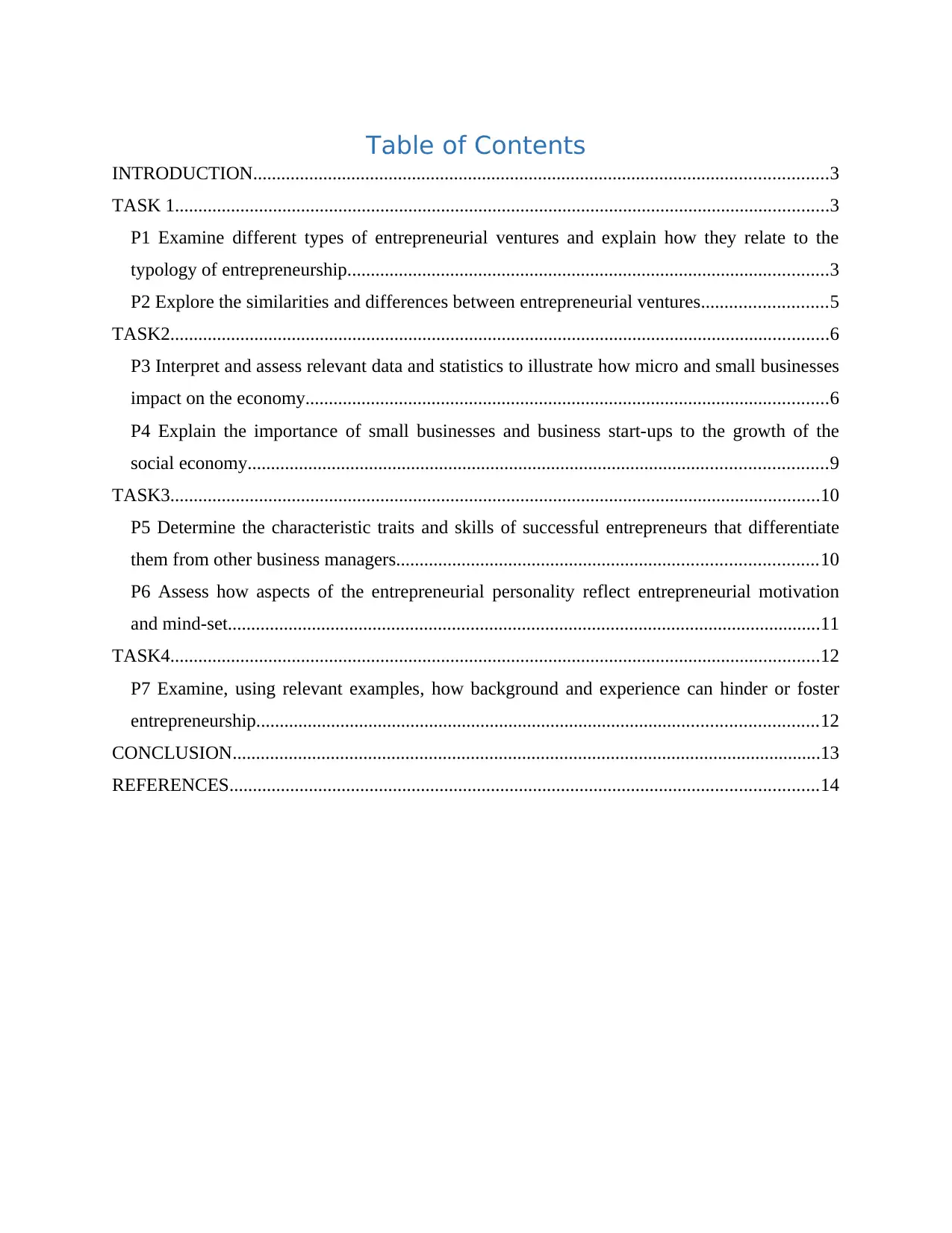
Table of Contents
INTRODUCTION...........................................................................................................................3
TASK 1............................................................................................................................................3
P1 Examine different types of entrepreneurial ventures and explain how they relate to the
typology of entrepreneurship.......................................................................................................3
P2 Explore the similarities and differences between entrepreneurial ventures...........................5
TASK2.............................................................................................................................................6
P3 Interpret and assess relevant data and statistics to illustrate how micro and small businesses
impact on the economy................................................................................................................6
P4 Explain the importance of small businesses and business start-ups to the growth of the
social economy............................................................................................................................9
TASK3...........................................................................................................................................10
P5 Determine the characteristic traits and skills of successful entrepreneurs that differentiate
them from other business managers..........................................................................................10
P6 Assess how aspects of the entrepreneurial personality reflect entrepreneurial motivation
and mind-set...............................................................................................................................11
TASK4...........................................................................................................................................12
P7 Examine, using relevant examples, how background and experience can hinder or foster
entrepreneurship........................................................................................................................12
CONCLUSION..............................................................................................................................13
REFERENCES..............................................................................................................................14
INTRODUCTION...........................................................................................................................3
TASK 1............................................................................................................................................3
P1 Examine different types of entrepreneurial ventures and explain how they relate to the
typology of entrepreneurship.......................................................................................................3
P2 Explore the similarities and differences between entrepreneurial ventures...........................5
TASK2.............................................................................................................................................6
P3 Interpret and assess relevant data and statistics to illustrate how micro and small businesses
impact on the economy................................................................................................................6
P4 Explain the importance of small businesses and business start-ups to the growth of the
social economy............................................................................................................................9
TASK3...........................................................................................................................................10
P5 Determine the characteristic traits and skills of successful entrepreneurs that differentiate
them from other business managers..........................................................................................10
P6 Assess how aspects of the entrepreneurial personality reflect entrepreneurial motivation
and mind-set...............................................................................................................................11
TASK4...........................................................................................................................................12
P7 Examine, using relevant examples, how background and experience can hinder or foster
entrepreneurship........................................................................................................................12
CONCLUSION..............................................................................................................................13
REFERENCES..............................................................................................................................14

INTRODUCTION
Entrepreneurship is described as a person's ability to start and operate a firm using an
inventive idea and cutting-edge technology. In today's climate, as prospects for entrepreneurship
grow, students must develop a variety of abilities and talents in order to combine them and
maximize the options available to them (Cao and Shi, 2021). The purpose of this study is to
address many elements of entrepreneurship. At the outset, the study will examine several
entrepreneurship ventures and explain how they are connected to the entrepreneurship typology.
There's also talk on how entrepreneurial projects are similar and different. The report's centre
section discusses numerous assets and data related to micro - small scale enterprises in a specific
corporate environment, as well as the value of small scale enterprises as start-ups for an
economy. Also there is analysis of the many attributes and features of a successful entrepreneur
that will aid them in running their firm, and how they might be gained by an individual. At the
conclusion of this study, there is a summary of how one's professional background might either
inhibit or encourage entrepreneurship.
TASK 1
P1 Examine different types of entrepreneurial ventures and explain how they relate to the
typology of entrepreneurship.
Entrepreneurship is a wide notion that refers to the process of creating, developing, and
operating a new business endeavour within a business environment by an individual who is
motivated to make a large profit by taking into account a variety of factors. Entrepreneur is a
term used to describe a person who begins a business. They organize, manage, and grow the
company, as well as create a venture with a unique product. There are several types of business
ventures, which are detailed below:
Large company entrepreneur venture: It refers to businesses or initiatives that operate in
the market by incorporating new and creative ideas and technology into their production
and facilitating a wide range of markets. These are those who introduce a new product to
a market where they currently trade and have a great presence (Pindado and Sánchez,
2017). This company's major goal is to enhance product capacity while also providing
appropriate client satisfaction through the creation of new features in their goods. The
goal of this company is to raise profits while also improving internal operations by
Entrepreneurship is described as a person's ability to start and operate a firm using an
inventive idea and cutting-edge technology. In today's climate, as prospects for entrepreneurship
grow, students must develop a variety of abilities and talents in order to combine them and
maximize the options available to them (Cao and Shi, 2021). The purpose of this study is to
address many elements of entrepreneurship. At the outset, the study will examine several
entrepreneurship ventures and explain how they are connected to the entrepreneurship typology.
There's also talk on how entrepreneurial projects are similar and different. The report's centre
section discusses numerous assets and data related to micro - small scale enterprises in a specific
corporate environment, as well as the value of small scale enterprises as start-ups for an
economy. Also there is analysis of the many attributes and features of a successful entrepreneur
that will aid them in running their firm, and how they might be gained by an individual. At the
conclusion of this study, there is a summary of how one's professional background might either
inhibit or encourage entrepreneurship.
TASK 1
P1 Examine different types of entrepreneurial ventures and explain how they relate to the
typology of entrepreneurship.
Entrepreneurship is a wide notion that refers to the process of creating, developing, and
operating a new business endeavour within a business environment by an individual who is
motivated to make a large profit by taking into account a variety of factors. Entrepreneur is a
term used to describe a person who begins a business. They organize, manage, and grow the
company, as well as create a venture with a unique product. There are several types of business
ventures, which are detailed below:
Large company entrepreneur venture: It refers to businesses or initiatives that operate in
the market by incorporating new and creative ideas and technology into their production
and facilitating a wide range of markets. These are those who introduce a new product to
a market where they currently trade and have a great presence (Pindado and Sánchez,
2017). This company's major goal is to enhance product capacity while also providing
appropriate client satisfaction through the creation of new features in their goods. The
goal of this company is to raise profits while also improving internal operations by
⊘ This is a preview!⊘
Do you want full access?
Subscribe today to unlock all pages.

Trusted by 1+ million students worldwide
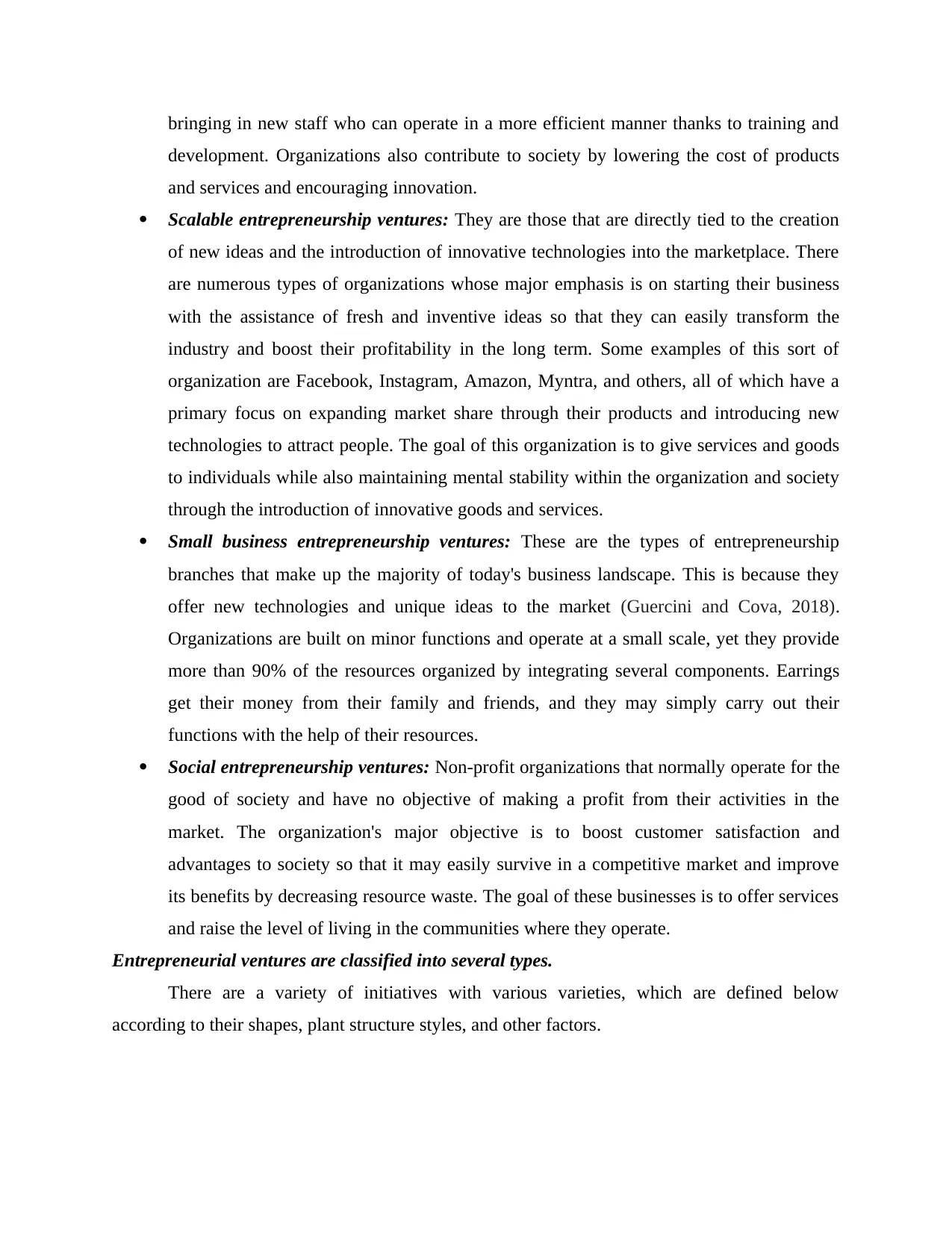
bringing in new staff who can operate in a more efficient manner thanks to training and
development. Organizations also contribute to society by lowering the cost of products
and services and encouraging innovation.
Scalable entrepreneurship ventures: They are those that are directly tied to the creation
of new ideas and the introduction of innovative technologies into the marketplace. There
are numerous types of organizations whose major emphasis is on starting their business
with the assistance of fresh and inventive ideas so that they can easily transform the
industry and boost their profitability in the long term. Some examples of this sort of
organization are Facebook, Instagram, Amazon, Myntra, and others, all of which have a
primary focus on expanding market share through their products and introducing new
technologies to attract people. The goal of this organization is to give services and goods
to individuals while also maintaining mental stability within the organization and society
through the introduction of innovative goods and services.
Small business entrepreneurship ventures: These are the types of entrepreneurship
branches that make up the majority of today's business landscape. This is because they
offer new technologies and unique ideas to the market (Guercini and Cova, 2018).
Organizations are built on minor functions and operate at a small scale, yet they provide
more than 90% of the resources organized by integrating several components. Earrings
get their money from their family and friends, and they may simply carry out their
functions with the help of their resources.
Social entrepreneurship ventures: Non-profit organizations that normally operate for the
good of society and have no objective of making a profit from their activities in the
market. The organization's major objective is to boost customer satisfaction and
advantages to society so that it may easily survive in a competitive market and improve
its benefits by decreasing resource waste. The goal of these businesses is to offer services
and raise the level of living in the communities where they operate.
Entrepreneurial ventures are classified into several types.
There are a variety of initiatives with various varieties, which are defined below
according to their shapes, plant structure styles, and other factors.
development. Organizations also contribute to society by lowering the cost of products
and services and encouraging innovation.
Scalable entrepreneurship ventures: They are those that are directly tied to the creation
of new ideas and the introduction of innovative technologies into the marketplace. There
are numerous types of organizations whose major emphasis is on starting their business
with the assistance of fresh and inventive ideas so that they can easily transform the
industry and boost their profitability in the long term. Some examples of this sort of
organization are Facebook, Instagram, Amazon, Myntra, and others, all of which have a
primary focus on expanding market share through their products and introducing new
technologies to attract people. The goal of this organization is to give services and goods
to individuals while also maintaining mental stability within the organization and society
through the introduction of innovative goods and services.
Small business entrepreneurship ventures: These are the types of entrepreneurship
branches that make up the majority of today's business landscape. This is because they
offer new technologies and unique ideas to the market (Guercini and Cova, 2018).
Organizations are built on minor functions and operate at a small scale, yet they provide
more than 90% of the resources organized by integrating several components. Earrings
get their money from their family and friends, and they may simply carry out their
functions with the help of their resources.
Social entrepreneurship ventures: Non-profit organizations that normally operate for the
good of society and have no objective of making a profit from their activities in the
market. The organization's major objective is to boost customer satisfaction and
advantages to society so that it may easily survive in a competitive market and improve
its benefits by decreasing resource waste. The goal of these businesses is to offer services
and raise the level of living in the communities where they operate.
Entrepreneurial ventures are classified into several types.
There are a variety of initiatives with various varieties, which are defined below
according to their shapes, plant structure styles, and other factors.
Paraphrase This Document
Need a fresh take? Get an instant paraphrase of this document with our AI Paraphraser

Lifestyle venture: These are businesses that are primarily focused on enhancing customer
pleasure while also supplying goods and services through delivering new services and
meeting client wants.
Aggressive growth venture: It covers companies who are primarily focused on upgrading
technology and bringing innovation to their manufacturing services so that they may
reduce competition from their competitors (Landström, 2017). They use an aggressive
strategy in which they operate on a huge scale and develop innovative items in order to
grow their market share and reduce the market share of their competitors.
Managed growth ventures: They operate with a primary focus on expanding the
organization's ability to manage a business for a longer length of time so that they may
function on a worldwide scale by delivering new goods and services via continuous
development. This sort of business always invests in training its employees so that they
may contribute to the organization's stability and profitability.
P2 Explore the similarities and differences between entrepreneurial ventures
SIMILARITIES
Social enterprise
This may be characterized as a sort of business that focuses solely on delivering
goods and services to customers without regard for profit.
The goal of these businesses is to offer services and raise the level of living in the
communities where they operate.
Entrepreneurial initiatives that are scalable
These are businesses that believe in large-scale manufacturing while also
improving consumer happiness by delivering high-quality items and product
innovation in order to last a long time (Hsieh and Wu, 2019).
The goal of this organization is to give services and goods to individuals while
also maintaining mental stability within the organization and society through the
introduction of innovative goods and services.
Entrepreneurial ventures by large corporations
An organization can be characterized as a company that levels and provides
production services to customers for large-scale building projects.
pleasure while also supplying goods and services through delivering new services and
meeting client wants.
Aggressive growth venture: It covers companies who are primarily focused on upgrading
technology and bringing innovation to their manufacturing services so that they may
reduce competition from their competitors (Landström, 2017). They use an aggressive
strategy in which they operate on a huge scale and develop innovative items in order to
grow their market share and reduce the market share of their competitors.
Managed growth ventures: They operate with a primary focus on expanding the
organization's ability to manage a business for a longer length of time so that they may
function on a worldwide scale by delivering new goods and services via continuous
development. This sort of business always invests in training its employees so that they
may contribute to the organization's stability and profitability.
P2 Explore the similarities and differences between entrepreneurial ventures
SIMILARITIES
Social enterprise
This may be characterized as a sort of business that focuses solely on delivering
goods and services to customers without regard for profit.
The goal of these businesses is to offer services and raise the level of living in the
communities where they operate.
Entrepreneurial initiatives that are scalable
These are businesses that believe in large-scale manufacturing while also
improving consumer happiness by delivering high-quality items and product
innovation in order to last a long time (Hsieh and Wu, 2019).
The goal of this organization is to give services and goods to individuals while
also maintaining mental stability within the organization and society through the
introduction of innovative goods and services.
Entrepreneurial ventures by large corporations
An organization can be characterized as a company that levels and provides
production services to customers for large-scale building projects.

The goal of this company is to raise profits while also improving internal
operations by bringing in new staff who can operate in a more efficient manner
thanks to training and development. Organizations also contribute to society by
lowering the cost of products and services and bringing innovation.
DIFFERENCES
Social enterprise
The main distinction between social enterprises and other businesses is that they
are focused on improving society's welfare by delivering various products and
services to society's customers in order to improve their well-being and level of
living.
Entrepreneurial initiatives that are scalable
Scalable businesses are ones that are focused on innovation and introducing new
technologies to the area in which they operate, as well as the society in which they
live. Companies are always focusing on growing their market share by raising
profit and enhancing productivity across several activities (Bridge and O'Neill,
2017). The company uses several motivating strategies to increase internal
knowledge of its products and services, as well as various advertisements to
attract diverse clients to the new technology.
Entrepreneurial efforts by large corporations
These are people who have a direct impact on an organization's innovation and
technology and utilize various approaches and tactics to inspire them to enhance
productivity. They are always bringing innovation to society on a broad scale, where
we may modify the environment and boost our chances by removing market rivalry.
TASK2
P3 Interpret and assess relevant data and statistics to illustrate how micro and small businesses
impact on the economy.
Data and statistics that demonstrate the economic effect of micro and small companies.
Small firms are designated as having a variety of regulations and responsibilities in the
UK economy (Hills and Morris, 2018). Display several regulations that involve varied economic
implications. Small companies in the United Kingdom make use of a variety of facilities and
operations by bringing in new staff who can operate in a more efficient manner
thanks to training and development. Organizations also contribute to society by
lowering the cost of products and services and bringing innovation.
DIFFERENCES
Social enterprise
The main distinction between social enterprises and other businesses is that they
are focused on improving society's welfare by delivering various products and
services to society's customers in order to improve their well-being and level of
living.
Entrepreneurial initiatives that are scalable
Scalable businesses are ones that are focused on innovation and introducing new
technologies to the area in which they operate, as well as the society in which they
live. Companies are always focusing on growing their market share by raising
profit and enhancing productivity across several activities (Bridge and O'Neill,
2017). The company uses several motivating strategies to increase internal
knowledge of its products and services, as well as various advertisements to
attract diverse clients to the new technology.
Entrepreneurial efforts by large corporations
These are people who have a direct impact on an organization's innovation and
technology and utilize various approaches and tactics to inspire them to enhance
productivity. They are always bringing innovation to society on a broad scale, where
we may modify the environment and boost our chances by removing market rivalry.
TASK2
P3 Interpret and assess relevant data and statistics to illustrate how micro and small businesses
impact on the economy.
Data and statistics that demonstrate the economic effect of micro and small companies.
Small firms are designated as having a variety of regulations and responsibilities in the
UK economy (Hills and Morris, 2018). Display several regulations that involve varied economic
implications. Small companies in the United Kingdom make use of a variety of facilities and
⊘ This is a preview!⊘
Do you want full access?
Subscribe today to unlock all pages.

Trusted by 1+ million students worldwide
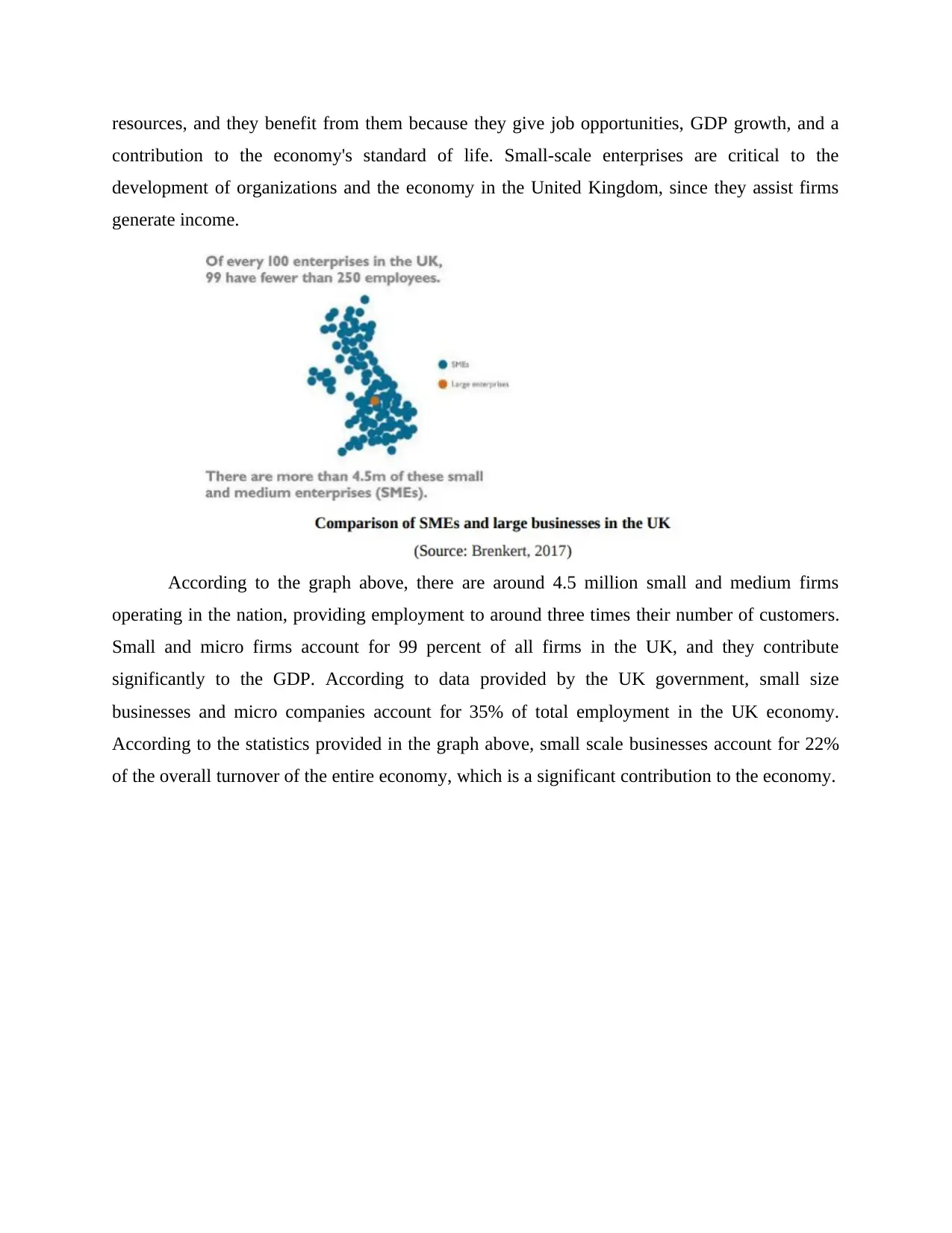
resources, and they benefit from them because they give job opportunities, GDP growth, and a
contribution to the economy's standard of life. Small-scale enterprises are critical to the
development of organizations and the economy in the United Kingdom, since they assist firms
generate income.
According to the graph above, there are around 4.5 million small and medium firms
operating in the nation, providing employment to around three times their number of customers.
Small and micro firms account for 99 percent of all firms in the UK, and they contribute
significantly to the GDP. According to data provided by the UK government, small size
businesses and micro companies account for 35% of total employment in the UK economy.
According to the statistics provided in the graph above, small scale businesses account for 22%
of the overall turnover of the entire economy, which is a significant contribution to the economy.
contribution to the economy's standard of life. Small-scale enterprises are critical to the
development of organizations and the economy in the United Kingdom, since they assist firms
generate income.
According to the graph above, there are around 4.5 million small and medium firms
operating in the nation, providing employment to around three times their number of customers.
Small and micro firms account for 99 percent of all firms in the UK, and they contribute
significantly to the GDP. According to data provided by the UK government, small size
businesses and micro companies account for 35% of total employment in the UK economy.
According to the statistics provided in the graph above, small scale businesses account for 22%
of the overall turnover of the entire economy, which is a significant contribution to the economy.
Paraphrase This Document
Need a fresh take? Get an instant paraphrase of this document with our AI Paraphraser

From the graph above, it can be seen that small businesses account for 99.3% of all
businesses in the UK, as well as providing the most jobs to diverse people. It is also estimated
that small size firms generate roughly 37% of the overall turnover of the UK following major
firms.
It has also been established that they have a stronger influence on the UK economy as well
as on the global economy, where the bulk of small scale enterprises produce various items. These
industries are noted for their innovative products, which account for around 24 percent of all
inventive products on the market, as well as their exports, which account for around 33 percent
of total sales. As a result, small-scale industry contributes to globalisation by assisting in the
businesses in the UK, as well as providing the most jobs to diverse people. It is also estimated
that small size firms generate roughly 37% of the overall turnover of the UK following major
firms.
It has also been established that they have a stronger influence on the UK economy as well
as on the global economy, where the bulk of small scale enterprises produce various items. These
industries are noted for their innovative products, which account for around 24 percent of all
inventive products on the market, as well as their exports, which account for around 33 percent
of total sales. As a result, small-scale industry contributes to globalisation by assisting in the
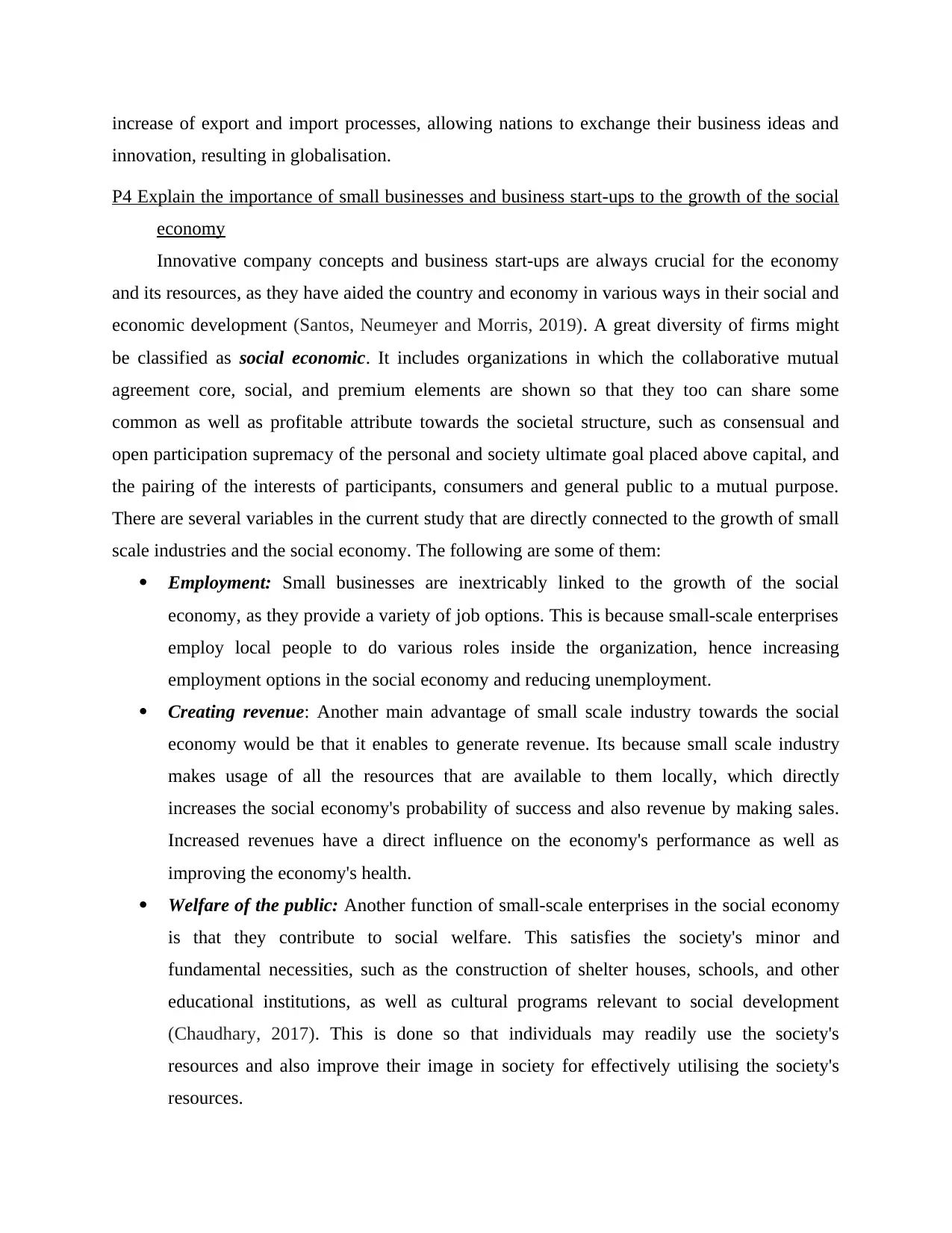
increase of export and import processes, allowing nations to exchange their business ideas and
innovation, resulting in globalisation.
P4 Explain the importance of small businesses and business start-ups to the growth of the social
economy
Innovative company concepts and business start-ups are always crucial for the economy
and its resources, as they have aided the country and economy in various ways in their social and
economic development (Santos, Neumeyer and Morris, 2019). A great diversity of firms might
be classified as social economic. It includes organizations in which the collaborative mutual
agreement core, social, and premium elements are shown so that they too can share some
common as well as profitable attribute towards the societal structure, such as consensual and
open participation supremacy of the personal and society ultimate goal placed above capital, and
the pairing of the interests of participants, consumers and general public to a mutual purpose.
There are several variables in the current study that are directly connected to the growth of small
scale industries and the social economy. The following are some of them:
Employment: Small businesses are inextricably linked to the growth of the social
economy, as they provide a variety of job options. This is because small-scale enterprises
employ local people to do various roles inside the organization, hence increasing
employment options in the social economy and reducing unemployment.
Creating revenue: Another main advantage of small scale industry towards the social
economy would be that it enables to generate revenue. Its because small scale industry
makes usage of all the resources that are available to them locally, which directly
increases the social economy's probability of success and also revenue by making sales.
Increased revenues have a direct influence on the economy's performance as well as
improving the economy's health.
Welfare of the public: Another function of small-scale enterprises in the social economy
is that they contribute to social welfare. This satisfies the society's minor and
fundamental necessities, such as the construction of shelter houses, schools, and other
educational institutions, as well as cultural programs relevant to social development
(Chaudhary, 2017). This is done so that individuals may readily use the society's
resources and also improve their image in society for effectively utilising the society's
resources.
innovation, resulting in globalisation.
P4 Explain the importance of small businesses and business start-ups to the growth of the social
economy
Innovative company concepts and business start-ups are always crucial for the economy
and its resources, as they have aided the country and economy in various ways in their social and
economic development (Santos, Neumeyer and Morris, 2019). A great diversity of firms might
be classified as social economic. It includes organizations in which the collaborative mutual
agreement core, social, and premium elements are shown so that they too can share some
common as well as profitable attribute towards the societal structure, such as consensual and
open participation supremacy of the personal and society ultimate goal placed above capital, and
the pairing of the interests of participants, consumers and general public to a mutual purpose.
There are several variables in the current study that are directly connected to the growth of small
scale industries and the social economy. The following are some of them:
Employment: Small businesses are inextricably linked to the growth of the social
economy, as they provide a variety of job options. This is because small-scale enterprises
employ local people to do various roles inside the organization, hence increasing
employment options in the social economy and reducing unemployment.
Creating revenue: Another main advantage of small scale industry towards the social
economy would be that it enables to generate revenue. Its because small scale industry
makes usage of all the resources that are available to them locally, which directly
increases the social economy's probability of success and also revenue by making sales.
Increased revenues have a direct influence on the economy's performance as well as
improving the economy's health.
Welfare of the public: Another function of small-scale enterprises in the social economy
is that they contribute to social welfare. This satisfies the society's minor and
fundamental necessities, such as the construction of shelter houses, schools, and other
educational institutions, as well as cultural programs relevant to social development
(Chaudhary, 2017). This is done so that individuals may readily use the society's
resources and also improve their image in society for effectively utilising the society's
resources.
⊘ This is a preview!⊘
Do you want full access?
Subscribe today to unlock all pages.

Trusted by 1+ million students worldwide
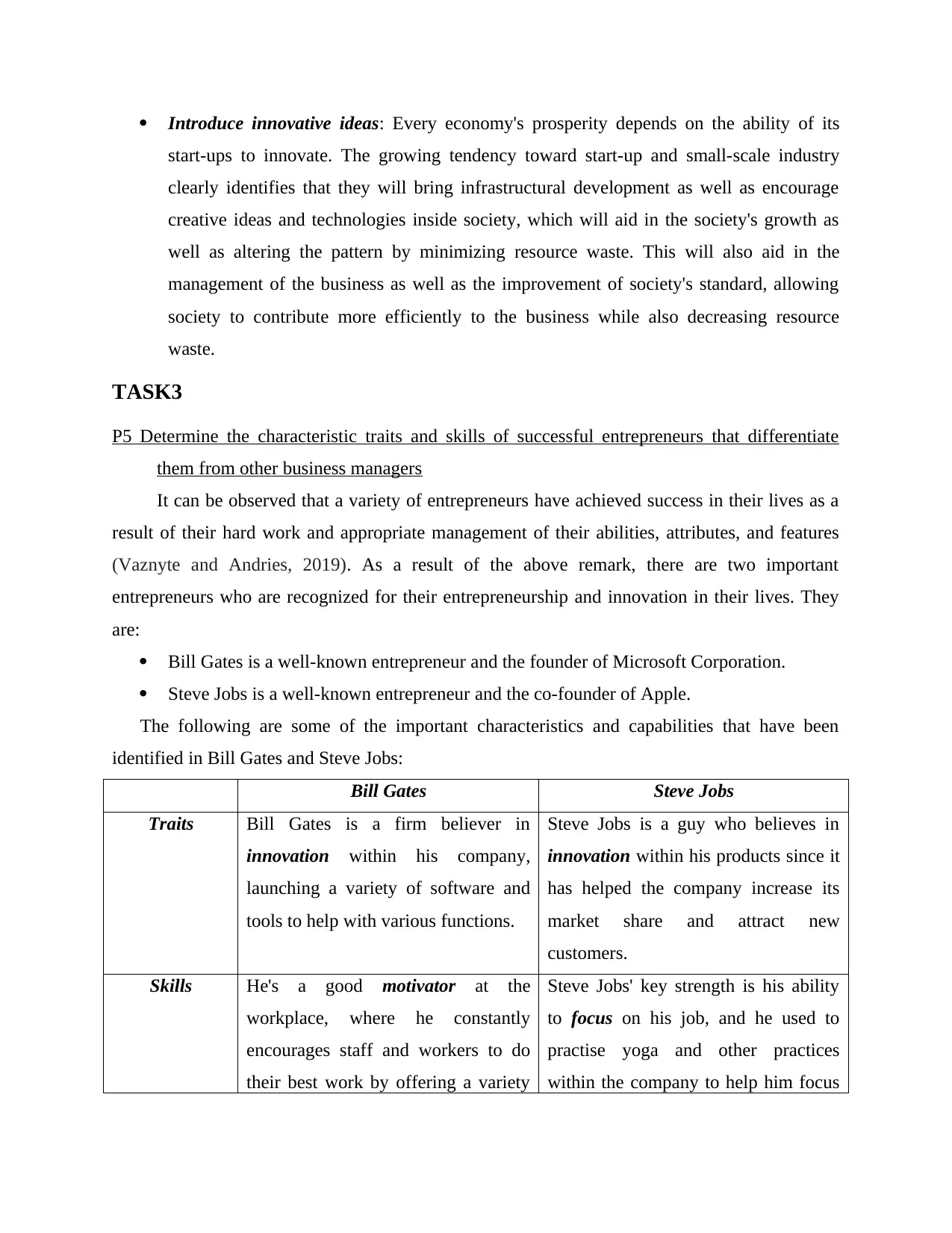
Introduce innovative ideas: Every economy's prosperity depends on the ability of its
start-ups to innovate. The growing tendency toward start-up and small-scale industry
clearly identifies that they will bring infrastructural development as well as encourage
creative ideas and technologies inside society, which will aid in the society's growth as
well as altering the pattern by minimizing resource waste. This will also aid in the
management of the business as well as the improvement of society's standard, allowing
society to contribute more efficiently to the business while also decreasing resource
waste.
TASK3
P5 Determine the characteristic traits and skills of successful entrepreneurs that differentiate
them from other business managers
It can be observed that a variety of entrepreneurs have achieved success in their lives as a
result of their hard work and appropriate management of their abilities, attributes, and features
(Vaznyte and Andries, 2019). As a result of the above remark, there are two important
entrepreneurs who are recognized for their entrepreneurship and innovation in their lives. They
are:
Bill Gates is a well-known entrepreneur and the founder of Microsoft Corporation.
Steve Jobs is a well-known entrepreneur and the co-founder of Apple.
The following are some of the important characteristics and capabilities that have been
identified in Bill Gates and Steve Jobs:
Bill Gates Steve Jobs
Traits Bill Gates is a firm believer in
innovation within his company,
launching a variety of software and
tools to help with various functions.
Steve Jobs is a guy who believes in
innovation within his products since it
has helped the company increase its
market share and attract new
customers.
Skills He's a good motivator at the
workplace, where he constantly
encourages staff and workers to do
their best work by offering a variety
Steve Jobs' key strength is his ability
to focus on his job, and he used to
practise yoga and other practices
within the company to help him focus
start-ups to innovate. The growing tendency toward start-up and small-scale industry
clearly identifies that they will bring infrastructural development as well as encourage
creative ideas and technologies inside society, which will aid in the society's growth as
well as altering the pattern by minimizing resource waste. This will also aid in the
management of the business as well as the improvement of society's standard, allowing
society to contribute more efficiently to the business while also decreasing resource
waste.
TASK3
P5 Determine the characteristic traits and skills of successful entrepreneurs that differentiate
them from other business managers
It can be observed that a variety of entrepreneurs have achieved success in their lives as a
result of their hard work and appropriate management of their abilities, attributes, and features
(Vaznyte and Andries, 2019). As a result of the above remark, there are two important
entrepreneurs who are recognized for their entrepreneurship and innovation in their lives. They
are:
Bill Gates is a well-known entrepreneur and the founder of Microsoft Corporation.
Steve Jobs is a well-known entrepreneur and the co-founder of Apple.
The following are some of the important characteristics and capabilities that have been
identified in Bill Gates and Steve Jobs:
Bill Gates Steve Jobs
Traits Bill Gates is a firm believer in
innovation within his company,
launching a variety of software and
tools to help with various functions.
Steve Jobs is a guy who believes in
innovation within his products since it
has helped the company increase its
market share and attract new
customers.
Skills He's a good motivator at the
workplace, where he constantly
encourages staff and workers to do
their best work by offering a variety
Steve Jobs' key strength is his ability
to focus on his job, and he used to
practise yoga and other practices
within the company to help him focus
Paraphrase This Document
Need a fresh take? Get an instant paraphrase of this document with our AI Paraphraser
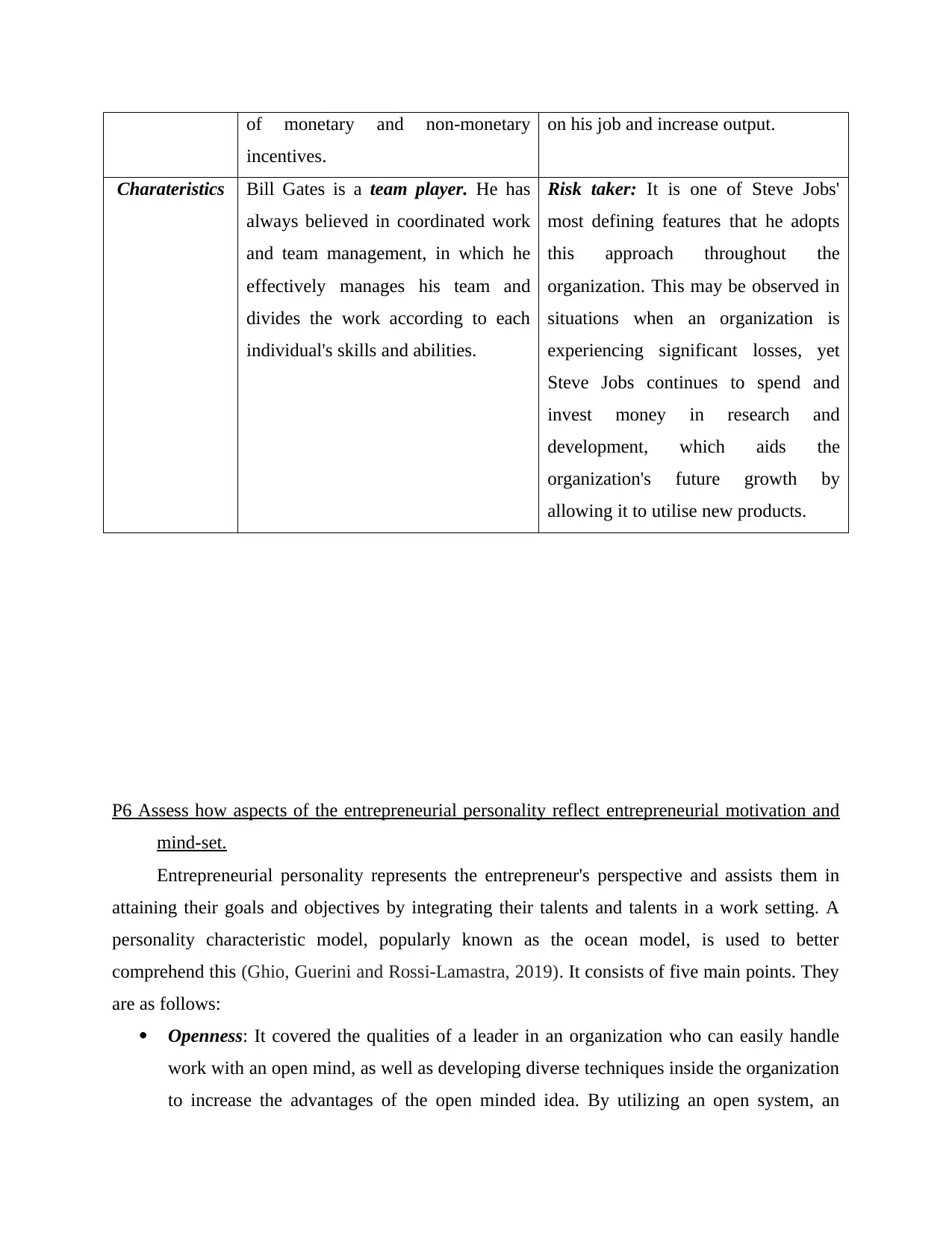
of monetary and non-monetary
incentives.
on his job and increase output.
Charateristics Bill Gates is a team player. He has
always believed in coordinated work
and team management, in which he
effectively manages his team and
divides the work according to each
individual's skills and abilities.
Risk taker: It is one of Steve Jobs'
most defining features that he adopts
this approach throughout the
organization. This may be observed in
situations when an organization is
experiencing significant losses, yet
Steve Jobs continues to spend and
invest money in research and
development, which aids the
organization's future growth by
allowing it to utilise new products.
P6 Assess how aspects of the entrepreneurial personality reflect entrepreneurial motivation and
mind-set.
Entrepreneurial personality represents the entrepreneur's perspective and assists them in
attaining their goals and objectives by integrating their talents and talents in a work setting. A
personality characteristic model, popularly known as the ocean model, is used to better
comprehend this (Ghio, Guerini and Rossi-Lamastra, 2019). It consists of five main points. They
are as follows:
Openness: It covered the qualities of a leader in an organization who can easily handle
work with an open mind, as well as developing diverse techniques inside the organization
to increase the advantages of the open minded idea. By utilizing an open system, an
incentives.
on his job and increase output.
Charateristics Bill Gates is a team player. He has
always believed in coordinated work
and team management, in which he
effectively manages his team and
divides the work according to each
individual's skills and abilities.
Risk taker: It is one of Steve Jobs'
most defining features that he adopts
this approach throughout the
organization. This may be observed in
situations when an organization is
experiencing significant losses, yet
Steve Jobs continues to spend and
invest money in research and
development, which aids the
organization's future growth by
allowing it to utilise new products.
P6 Assess how aspects of the entrepreneurial personality reflect entrepreneurial motivation and
mind-set.
Entrepreneurial personality represents the entrepreneur's perspective and assists them in
attaining their goals and objectives by integrating their talents and talents in a work setting. A
personality characteristic model, popularly known as the ocean model, is used to better
comprehend this (Ghio, Guerini and Rossi-Lamastra, 2019). It consists of five main points. They
are as follows:
Openness: It covered the qualities of a leader in an organization who can easily handle
work with an open mind, as well as developing diverse techniques inside the organization
to increase the advantages of the open minded idea. By utilizing an open system, an

individual may do a variety of tasks in order to increase and sustain sound policies inside
an organization.
Consciousness: It is a significant capacity of an individual or a leader within an
organization that is necessary to accomplish a variety of tasks (Jose, 2018). This is
because business is dynamic, with a variety of scenarios that may have an influence on
the organization's company as well as an individual's mindset, so it must be aware of the
Spectre and make policies and decisions in accordance with it.
Extraversion: It is a representation of an individual's or a company's energy that allows
them to function as a proper entrepreneur, able to link various functions within the
organization in a socially acceptable manner while also maintaining the lives of each
individual in an appropriate manner, where young people can mix with older people and
experience can mix with inexperience.
Agreeableness: It is a situation in which individuals within an organization must exert
control over themselves as if they were the wealthiest person in the society in which the
organization operates. With the passage of time, this will transform an individual into a
proper leader.
Neuroticism: It is the final step of this paradigm, where an individual's qualities must be
integrated in order to establish correct sensitivity and stability in one's mind in order to
react appropriately in times of rage and despair (Guerrero and Urbano, 2019). This makes
them an excellent leader since they can easily manage their wrath and emotion in difficult
situations, as well as a proper entrepreneur who can operate in a profit-oriented manner.
TASK4
P7 Examine, using relevant examples, how background and experience can hinder or foster
entrepreneurship.
There are several aspects that can assist determine an individual's degree of talents and
attributes based on their future and past. Some of these elements have been discovered in order
to learn more about the effects of background and experience on entrepreneurship. The following
are some of the aspects to consider:
Education and personal background: An individual's personal experience and education
have a significant effect on their decision to launch a new company endeavor. This is
an organization.
Consciousness: It is a significant capacity of an individual or a leader within an
organization that is necessary to accomplish a variety of tasks (Jose, 2018). This is
because business is dynamic, with a variety of scenarios that may have an influence on
the organization's company as well as an individual's mindset, so it must be aware of the
Spectre and make policies and decisions in accordance with it.
Extraversion: It is a representation of an individual's or a company's energy that allows
them to function as a proper entrepreneur, able to link various functions within the
organization in a socially acceptable manner while also maintaining the lives of each
individual in an appropriate manner, where young people can mix with older people and
experience can mix with inexperience.
Agreeableness: It is a situation in which individuals within an organization must exert
control over themselves as if they were the wealthiest person in the society in which the
organization operates. With the passage of time, this will transform an individual into a
proper leader.
Neuroticism: It is the final step of this paradigm, where an individual's qualities must be
integrated in order to establish correct sensitivity and stability in one's mind in order to
react appropriately in times of rage and despair (Guerrero and Urbano, 2019). This makes
them an excellent leader since they can easily manage their wrath and emotion in difficult
situations, as well as a proper entrepreneur who can operate in a profit-oriented manner.
TASK4
P7 Examine, using relevant examples, how background and experience can hinder or foster
entrepreneurship.
There are several aspects that can assist determine an individual's degree of talents and
attributes based on their future and past. Some of these elements have been discovered in order
to learn more about the effects of background and experience on entrepreneurship. The following
are some of the aspects to consider:
Education and personal background: An individual's personal experience and education
have a significant effect on their decision to launch a new company endeavor. This is
⊘ This is a preview!⊘
Do you want full access?
Subscribe today to unlock all pages.

Trusted by 1+ million students worldwide
1 out of 14
Related Documents
Your All-in-One AI-Powered Toolkit for Academic Success.
+13062052269
info@desklib.com
Available 24*7 on WhatsApp / Email
![[object Object]](/_next/static/media/star-bottom.7253800d.svg)
Unlock your academic potential
Copyright © 2020–2025 A2Z Services. All Rights Reserved. Developed and managed by ZUCOL.


![Entrepreneurship and Small Business Impact Report - [University Name]](/_next/image/?url=https%3A%2F%2Fdesklib.com%2Fmedia%2Fimages%2Fwj%2Fd1f42599211847658d3fd556aa563fa5.jpg&w=256&q=75)

